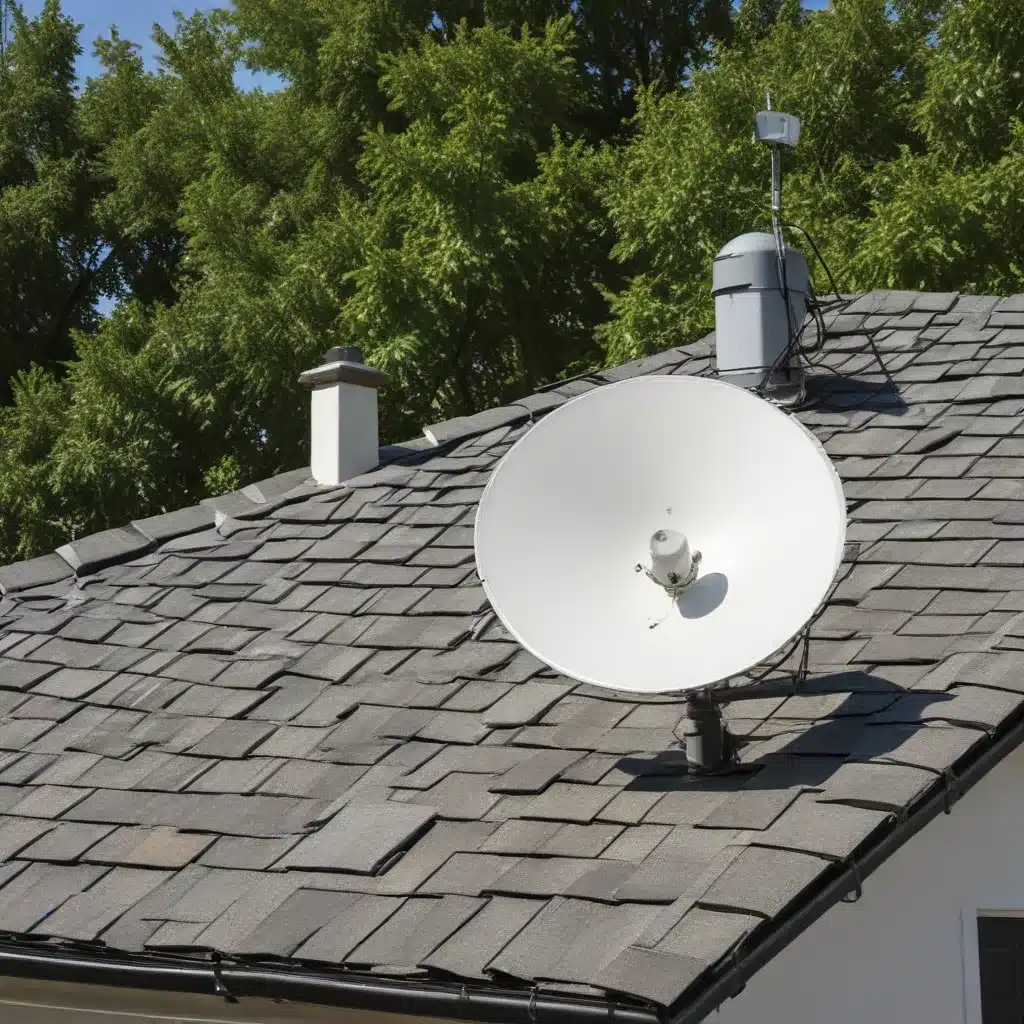
The Importance of Proper Installation and Maintenance
As a seasoned roofing professional, I’ve seen the impacts that improper installation and neglected maintenance can have on roof-mounted antennas and satellite dishes. These crucial components can be vulnerable to weather, environmental factors, and even lightning strikes if not properly protected. In this comprehensive guide, I’ll share practical tips and in-depth insights to help you safeguard your roof-mounted equipment and ensure optimal performance.
Choosing the Right Mounting Solution
The foundation of a reliable roof-mounted antenna or satellite dish is the mounting system. When selecting a non-penetrating roof mount, it’s essential to choose a product designed to protect the integrity of your roof. Look for mounts that come with a protective rubber mat or pad, like the ROHN FRMPAD Protective Barrier Pad. This weatherproof foam pad creates a barrier between the mount and the roof surface, preventing damage and ensuring a secure, leak-proof installation.
Additionally, consider the size and weight of your antenna or dish when choosing a mount. Heavier equipment may require a more robust, reinforced solution to withstand strong winds and weathering. Consulting with a roofing professional can help you select the optimal mounting system for your specific needs.
Grounding and Lightning Protection
One of the primary concerns with roof-mounted antennas and satellite dishes is the risk of lightning strikes. Proper grounding is essential to protect your equipment and prevent potential fire hazards or electrical damage. When installing your antenna or dish, make sure to connect it to a dedicated grounding rod or the building’s existing grounding system.
For added lightning protection, consider installing a lightning arrestor or surge protector inline with your coaxial cable. These devices act as a barrier, diverting harmful electrical surges away from your sensitive electronics. Regularly inspecting your grounding connections and lightning protection equipment is also recommended to ensure they remain in good working order.
Maintaining a Weather-Resistant Seal
Ensuring a weatherproof seal around your roof-mounted equipment is crucial to prevent water intrusion and potential leaks. When installing the mount, use a high-quality sealant or roofing cement to create a tight, durable bond between the mount and the roof surface. Periodically inspect the sealant and reapply as needed to maintain the integrity of the seal.
For added protection, consider using a non-penetrating roof mount that eliminates the need for roof penetrations altogether. These types of mounts, like the ones offered by 3 Star Inc., utilize a weighted base or suction cups to secure the mount without compromising the roof’s waterproofing.
Optimizing Antenna Placement and Accessibility
The positioning of your roof-mounted antenna or satellite dish can significantly impact its performance and accessibility for maintenance. When possible, aim to install the equipment on the highest point of your roof, as this can improve signal quality and reception. However, be mindful of any potential safety concerns, such as proximity to power lines or the risk of the antenna being blown loose in high winds.
Additionally, consider the ease of access for future maintenance and repairs. Selecting a location that allows you or a service technician to safely reach the equipment can save time and effort down the line. Ensuring adequate clearance around the antenna or dish can also simplify tasks like cleaning or adjusting the alignment.
Addressing Roof Penetrations
In some cases, a roof-mounted antenna or satellite dish may require a penetration through the roof to accommodate the cable or mast. When drilling holes, it’s essential to use proper sealants and flashing to maintain the roof’s waterproofing integrity. Consult with a roofing professional to ensure the penetration is executed correctly and sealed effectively to prevent leaks.
If you’re renting or living in a shared housing community, be aware of any restrictions or guidelines regarding roof penetrations. The FCC’s Over-the-Air Reception Devices (OTARD) rule provides some protections for antenna and satellite dish installations, but it’s always best to communicate with your landlord or homeowners association before making any modifications to the roof.
Attic-Mounted Alternatives
For those seeking a less invasive installation option, an attic-mounted antenna or satellite dish may be a viable alternative. While this setup can provide good signal reception without the need for roof penetrations, it’s essential to consider the potential impact on the signal quality.
According to the information gathered from the Reddit community, an attic-mounted antenna may experience some degradation in signal strength compared to a roof-mounted solution, due to the increased distance and potential interference from building materials. However, the reduced risk of weather-related damage and lightning strikes can make an attic-mounted setup an attractive option for some homeowners.
If you choose an attic-mounted antenna, be sure to still ground the equipment and consider any additional measures, such as surge protection, to safeguard your investment. Consulting with a local roofing professional in Northampton can help you evaluate the best placement and installation approach for your specific needs.
Prioritizing Safety
Throughout the installation and maintenance of your roof-mounted antennas or satellite dishes, safety should be the top priority. Ensure that you or any service technicians have the proper personal protective equipment (PPE), such as harnesses, safety glasses, and non-slip footwear, when working on the roof.
Additionally, be mindful of potential hazards, such as power lines, loose debris, or unstable roof surfaces. If you’re not comfortable or confident in performing the work yourself, it’s always best to hire a licensed and experienced roofing contractor to handle the installation and maintenance tasks.
Conclusion
Protecting your roof-mounted antennas and satellite dishes is crucial for ensuring reliable performance and long-term durability. By following best practices for mounting, grounding, sealing, and maintaining these crucial components, you can safeguard your investment and enjoy uninterrupted access to your desired communication or entertainment services.
Remember, your local Northampton roofing experts are always available to provide guidance, assess your specific needs, and ensure your roof-mounted equipment is installed and maintained to the highest standards. Don’t hesitate to reach out if you have any questions or concerns about protecting your roof-mounted antennas and satellite dishes.

